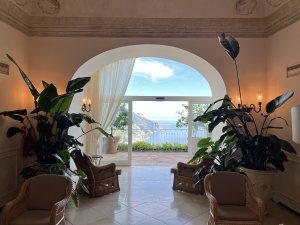The Home of Lemonchello
Limoncello (Italian pronunciation: [limonˈtʃɛlːo]) is an Italian lemon liqueur mainly produced in Southern Italy, especially in the region around the Sorrentine Peninsula and the coast of Amalfi. It is the second most popular liqueur in Italy and is traditionally served chilled as an after-dinner digestivo. It is also a popular homemade liqueur, with various recipes available online and in print.
Limoncello is made from the zest of lemons and usually has a slightly turbid appearance, which originates from the presence of small essential oil droplets suspended in the drink.
Spectacular Seafood
The Amalfi Coast is known for its stunning coastal scenery and delicious seafood cuisine. Many restaurants in the region offer a wide variety of seafood dishes, often featuring locally caught fish and shellfish. Popular dishes include spaghetti alle vongole, a pasta dish made with clams and garlic, and scialatielli ai frutti di mare, a type of homemade pasta with mixed seafood.
One of the most sought-after seafood dishes in the area is baccalà alla napoletana, a salted cod dish that is typically served with tomatoes, onions, and capers. Another popular option is grilled or roasted octopus, which is often served with potatoes and a drizzle of olive oil. Visitors to the Amalfi Coast can also enjoy a variety of fresh fish dishes, including grilled or baked sea bass, swordfish, and red mullet. Overall, the seafood offerings in the Amalfi Coast restaurants are diverse and delicious, showcasing the region’s rich culinary heritage and proximity to the sea.
Wedding in the Amalfi Village Square
Amalfi is a small town located on the Amalfi Coast in the Campania region of southern Italy. The town has a rich history dating back to the Roman Empire, when it was an important trading port. However, it wasn’t until the Middle Ages that Amalfi really flourished. In the 9th century, it became an independent republic with a powerful navy that dominated the Mediterranean. The town became known for its shipbuilding and maritime trade, and its merchants travelled as far as the Black Sea and the Middle East. Amalfi was also famous for its production of paper, which was made from rags and used for books and documents. This industry was so important that the word “amalfitano” became synonymous with “paper” in many languages.
The glory days of Amalfi came to an end in the 12th century, when it was conquered by the Normans. The town was sacked and its population was drastically reduced. However, Amalfi remained an important cultural and artistic center, and its architecture and art reflect the various influences of its history. Today, the town is a popular tourist destination, known for its picturesque location on the coast, its beautiful beaches, and its historic center, which is a UNESCO World Heritage Site.


Adventure Resources
(c)2004 - 2025 Magnus Adventures, Inc.
Error: Contact form not found.